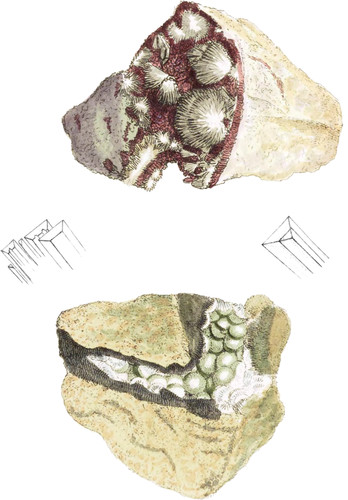 Enlarge
Enlarge
British Mineralogy
Hydrate of Argill, or Hydrargillite
- Class 2. Earths.
- Order 1. Homogeneous.
- Gen. 1. Argill.
- Spec. 2. Hydrate.
According to our expectation before expressed, we are enabled to give figures from Cornish specimens of this substance by favour of the Rev. Mr. Gregor, who lent us his best specimen, which is represented in the upper figure. This is in looser radii than those from Barnstaple, but appears to agree precisely in the form of the crystal, which, according to our idea, shows more of the primitive faces, (viz.) the flat sides of the column, as that shows only one primitive face at the apex. We could not attempt to measure these crystals, they are so extremely small. The gangue is also different. We retain Mr. Davy’s name of Hydrargillite, although Mr. Gregor believes there is an acid contained in it, but it is not determined what acid, or whether it is essential to the mineral. It is formed in the hollows of the rock or gangue, with Quartz crystals coloured with red Oxide of Iron more or less sticking in mammillæ about them, probably mixed with Oxide of Copper; but it has not undergone regular examination. On some parts of the gangue there appears to be Oxide of Uranite: see tab. 124; and Mr. Regor, by some trials made with small quantities, thinks it contains, beside Uranium, a little Oxide of Lead, Lime, Silica, and a metallic substance differing in properties from Uranium.
We hope this will be further examined. Mr. G.’s paper on the subject to the Royal Soceity has been read, but is not yet printed. We have another specimen from our friend Mr. Rashleigh, where the spiculæ are much smaller, and the bundles composed in such a manner as to give it a cottony appearance, whilst a few of the crystals are nearly like the above.
We have annexed to the plate a specimen from our liberal friend last mentioned, which accords extremely well with the common appearance of that from Barnstaple, showing them to be the same, which has been doubted, and the crystallization sufficiently corresponds with them. The part of the gangue in which this is imbedded is of a grayish colour, and somewhat though not distinctly approaching a schistose appearance, like those from Barnstaple. The rest of the matrix resembles that of the others from Cornwall, which are whitish Quartz mingled with soft Mica, such as the Cornish Apatite is generally found in. Those from Cornwall were supposed to be different species from those from Barnstaple. We are more confident with regard to the crystals, having been favoured by Dr. Wavell with many interesting specimens, some of which have a pearly appearance not before mentioned. All the specimens figured at the present plate are from Stenna Gwinn in Cornwall.

